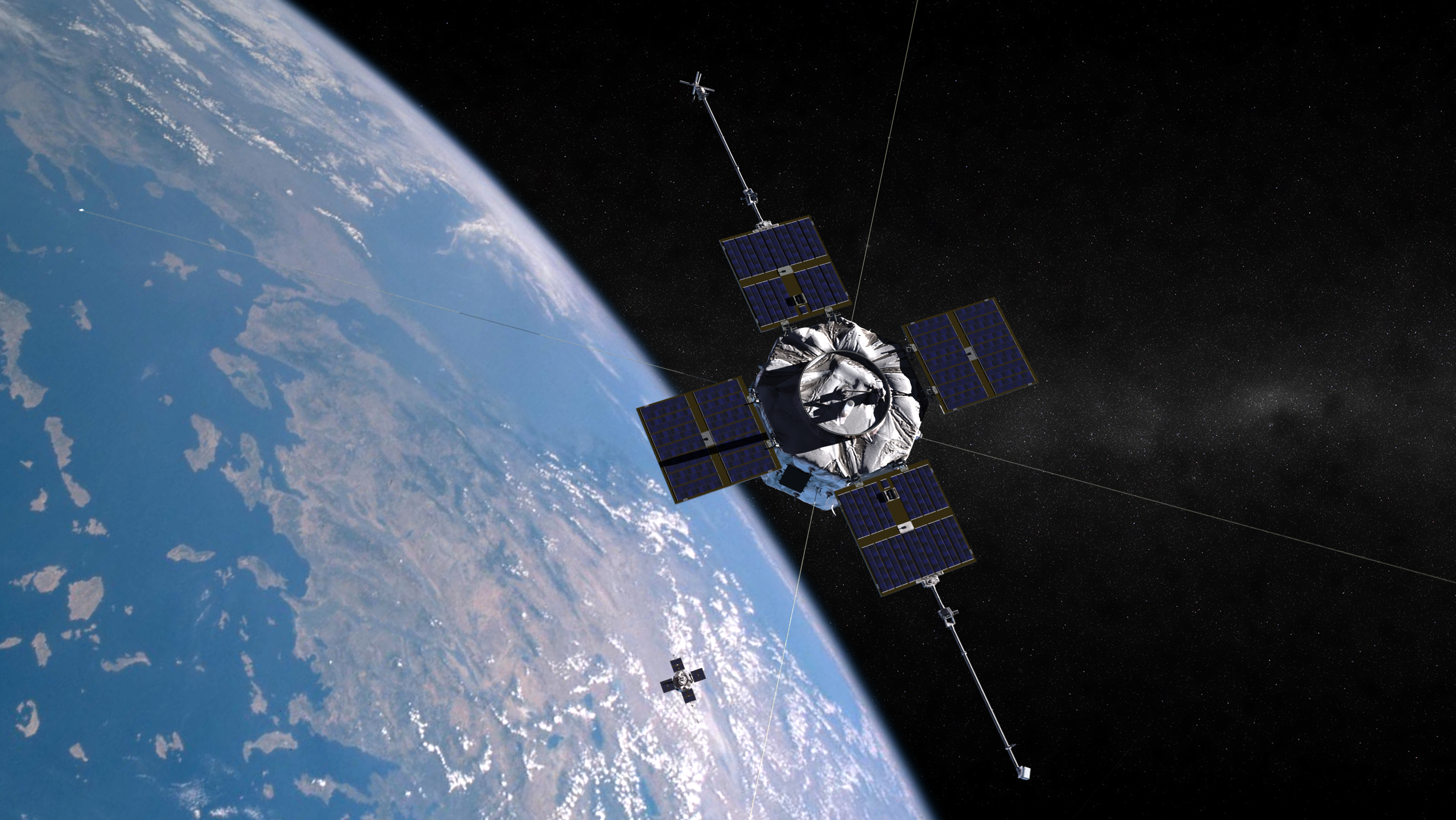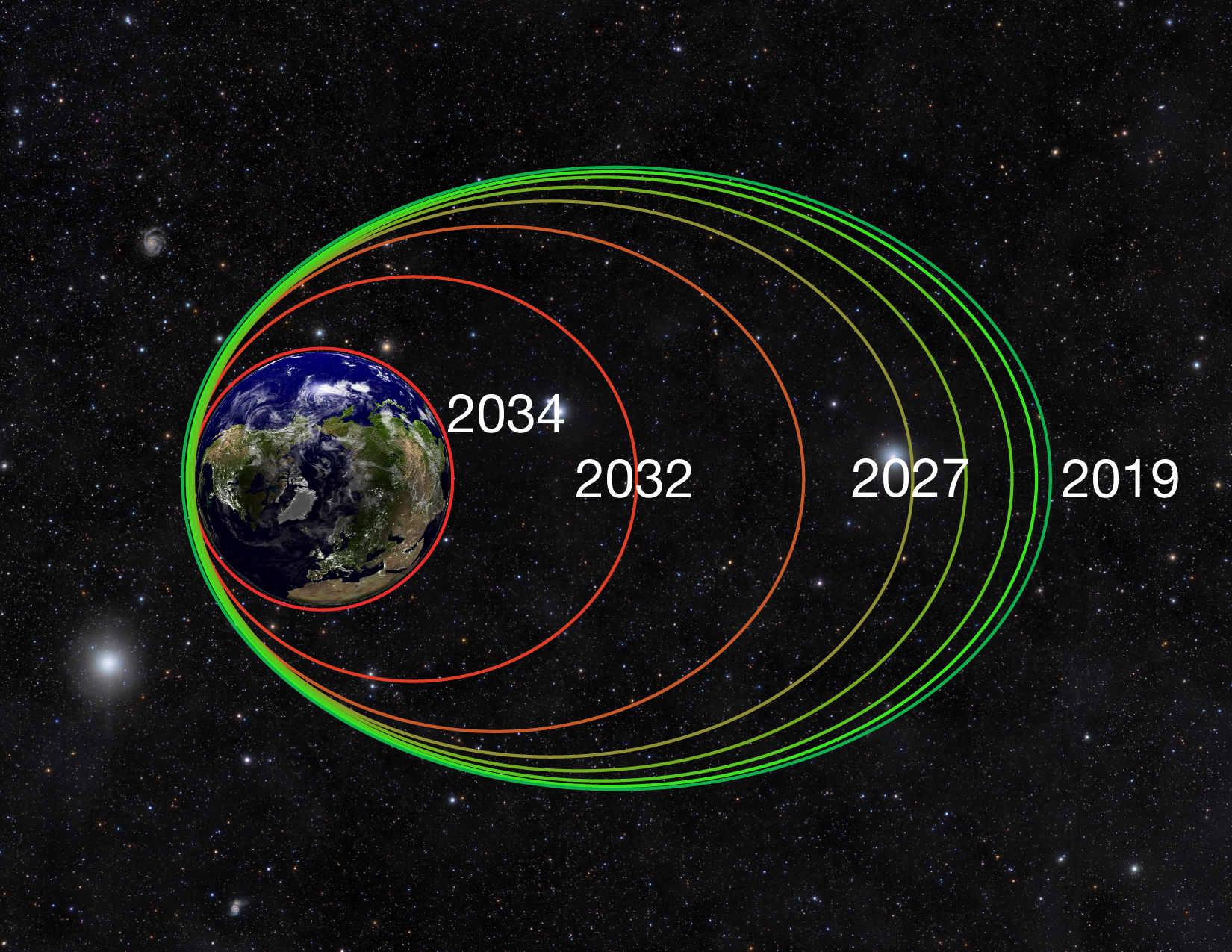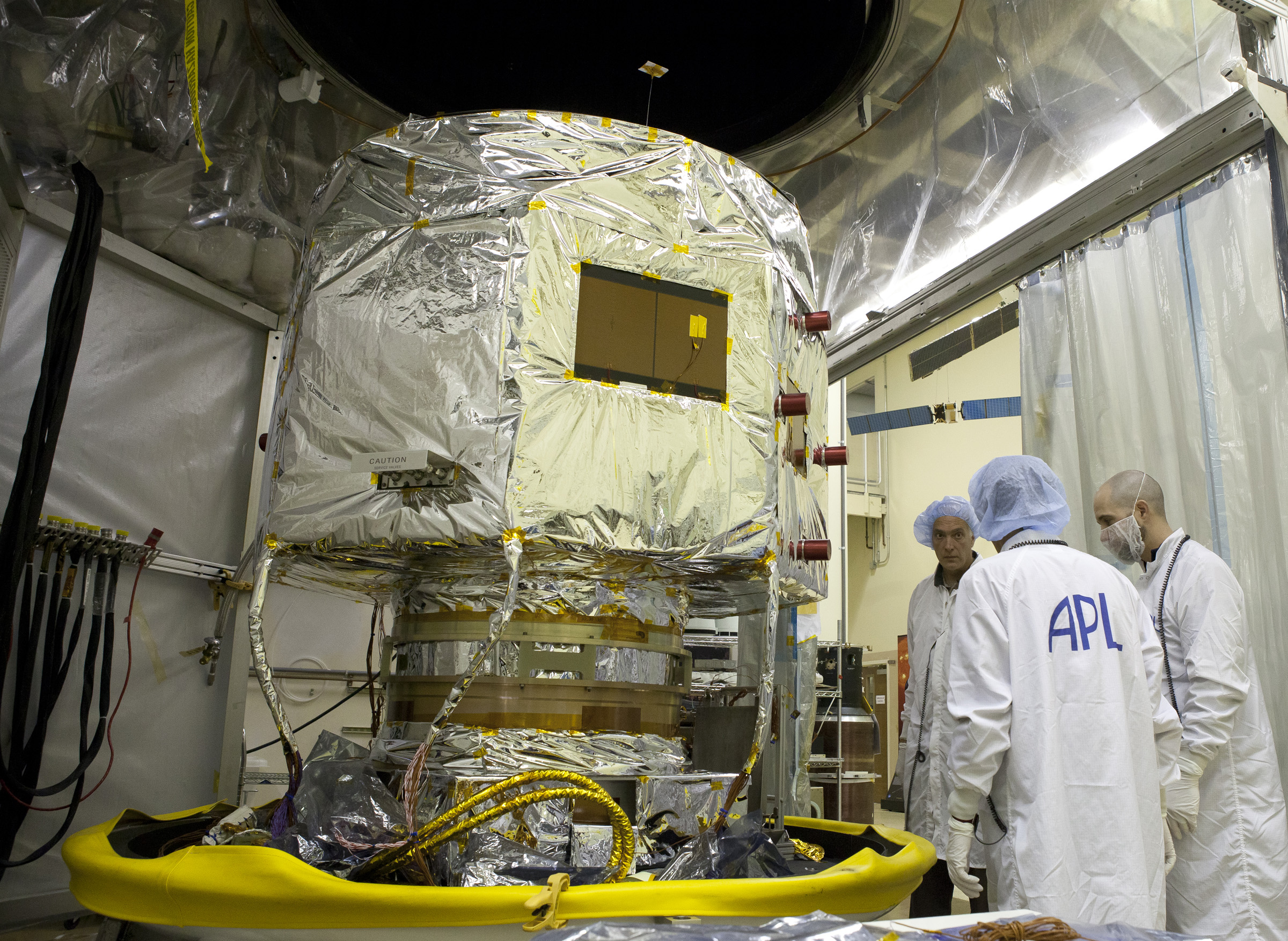February 10, 2019
Radiation Belts Revealed and Conquered, NASA's Van Allen Probes Begin Final Phase of Exploration

Launched on August 31, 2012, the twin Van Allen Probes carried identical suites of five instruments to explore the Van Allen radiation belts above Earth. The instruments measure the particles, magnetic and electric fields, and waves in this harsh radiation environment, giving researchers insights into the belts and space weather. In 2019, the mission begins a de-orbit maneuver that will allow the spacecraft to safely burn up in the Earth's atmosphere in about 15 years. Credit: NASA/Johns Hopkins APL/Steve Gribben
Two tough, resilient NASA spacecraft have been orbiting Earth for the past six and a half years, flying repeatedly through a hazardous zone of charged particles known as the Van Allen radiation belts. Designed to study these areas above our planet, previously thought to be stable and well-understood, the twin Van Allen Probes – launched in August 2012 – have confirmed scientific theories and revealed new structures, compositions, and processes at work in these dynamic regions.

This chart shows the change in the orbit of the Van Allen Probes that will occur after de-orbit maneuvers in February and March 2019. The spacecrafts' highly elliptical orbits will gradually tighten over the next 15-25 years as the Van Allen Probes begin to experience atmospheric drag at their perigee, or lowest point of orbit. The drag will pull the elliptical orbit into a circular one as early as 2034, at which time the spacecraft will begin to enter the atmosphere and safely disintegrate. Credit: Johns Hopkins APL
On February 12, the Van Allen Probes mission operations team at the Johns Hopkins Applied Physics Laboratory (APL) in Laurel, Maryland – where the probes were designed and built – will begin a series of orbit descent maneuvers that will last into March. These changes will change the lowest point of orbit, or perigee, of both spacecraft some 161 miles (260 km) in order to position them for an eventual re-entry into Earth's atmosphere, in approximately 15 years. "In order for the Van Allen Probes to have a controlled re-entry within a reasonable amount of time, we need to lower the perigee," said Nelli Mosavi, project manager for the Van Allen Probes at the Johns Hopkins Applied Physics Laboratory, or APL, in Laurel, Maryland. "At the new altitude, aerodynamic drag will bring down the satellites and eventually burn them up in the upper atmosphere. Our mission is to obtain great science data, and also to ensure that we prevent more space debris so the next generations have the opportunity to explore the space as well."
Originally designated as a two-year mission – based on predictions that no spacecraft could survive much longer operating in the harsh radiation belts – these rugged spacecraft have operated without incident since 2012, and continue to enable groundbreaking discoveries about the Van Allen Belts. "The spacecraft and instruments have given us incredible insight into spacecraft operations in a high-radiation environment," Mosavi said. "Everyone on the mission feels a real sense of pride and accomplishment in the work we've done and the science we've provided to the world – even as we begin the de-orbiting maneuvers."
The Van Allen Radiation Belts
"The radiation belts are doughnut-shaped bands of energized particles – protons and electrons – trapped around, and endlessly circling, the Earth at distances above the planet's surface, ranging from several hundred miles to a tenth of the distance to the Moon," explained mission scientist David Sibeck, of NASA's Goddard Space Flight Center in Greenbelt, Maryland.
"We know that other planets in our solar system with magnetic fields have radiation belts," said project scientist Sasha Ukhorskiy of APL, "and we can assume that other bodies throughout the universe do too. By studying the belts and the physics associated with them here at Earth, and using our world as a natural laboratory, we can learn about how these structures function around other objects in the universe with magnetic fields."
Earth's radiation belts – and the twin spacecraft that study them – are named for James Van Allen, whose work in space science and exploration, particularly with the 1958 Explorer I spacecraft, led to some of the earliest detailed study and definition of these regions of space.
Since 2012, the Van Allen Probes have traveled in an elliptical orbit around the Earth, through the inner region of the Earth's geomagnetic field.
In this region, many of the magnetic field lines intersect the surface of the Earth in the north and south. This means that lower energy ions and electrons, some 'boiled off' the Earth's ionosphere by solar ultraviolet radiation, can be trapped along these field lines. The charged particles spend their time bouncing between the 'mirror points' in the Earth's magnetic field. This trapped population forms the radiation belts around the Earth. The radiation created by this charged particle population can be hazardous to satellites and astronauts so it is important to understand their characteristics.
"These areas of trapped radiation were the first scientific discovery of humanity's pioneering spacecraft missions in the late 1950s," said Ukhorskiy. "After more than fifty years of study, we understand that the near-Earth radiation region is a complex and dynamic environment. But profound mysteries remained that called for designing a new mission – the Van Allen Probes – with uniquely capable scientific instrumentation that can capture all particle populations in the radiation belts and resolve the processes that drive and guide them."
Since their launch from Cape Canaveral Air Force Station, Florida on Aug. 30, 2012, the twin Van Allen Probes have delivered to scientists an unprecedented look into the make-up and processes within the belts. The spacecrafts' orbits are highly eccentric: at perigee, they swoop to within about 373 miles (600 km) of the planet's surface, then out to an apogee of more than 19,417 miles (31,250 km). Twin spacecraft provide their instruments with the opportunity to deliver different (in time and space) looks at the same features of the belts, giving scientists a detailed image of how particle and wave events begin and change.
"Everything that happens in the radiation belts begins with the Sun," said Sibeck. "The Sun periodically sends out blasts of plasma that batter our own Earth's magnetic field." The magnetic field creates a bubble known as the magnetosphere, which protects our planet from these plasma blasts – but it also serves to capture the particles within them, eventually settling these high-energy particle populations into the radiation belts around the Earth.
Some of these particles are moving at speeds approaching that of the speed of light – over 670 million miles an hour. They are accelerated to those speeds by a complex chain of processes that occur in the near-Earth space, a region which acts like a giant particle accelerator. The highly energized particles in the radiation belts can pose a number of hazards to space operations, as the they can damage sensitive electronics.
During solar storms, conditions worsen, and the belts can swell in size, threatening nearby spacecraft. "Our magnetic field does a pretty good job of shielding us from these solar blasts," said Sibeck, "but some of their energy penetrates deep into the Earth's field and, through a variety of mechanisms, powers up the radiation belts. When that happens, spacecraft in the belts had better look out. Trouble lies ahead in the form of short circuits, disrupted computer memory, and instrument failure."
The Van Allen Probes were designed and built to be resilient to this harsh environment.
"Over the past six and a half years, the Van Allen Probes have completed three full circuits around the magnetosphere, and measured more than 100 geomagnetic storms," said Ukhorskiy. "The Van Allen Probes verified and quantified previously suggested theories, discovered new mechanisms that can sculpt near-Earth energetic particle populations, and used uniquely capable instruments to unveil unexpected features that were all but invisible to previous sensors."
The information on particles and waves delivered by the Van Allen Probes has proven to be a treasure trove for space physics research. Findings and observations include multiple belt structures, including a third belt observed shortly after launch; definitive answers about particle acceleration processes; and the discovery of a nearly impenetrable barrier region that prevents the fastest and most energetic electrons from reaching Earth.
"The data from the Van Allen Probes has led to more than 560 articles published in peer-reviewed science journals since the launch of the mission," he continued. "Most of these articles are led by the authors not directly affiliated with the mission's science teams. And the publication rate has steadily grown since the mission launch; every four days, a new article is published in an international peer-reviewed journal."

In this late 2010 photo, engineers at the Johns Hopkins Applied Physics Laboratory in Laurel, Md., prepare to place Van Allen Probes spacecraft "B" in a thermal-vacuum chamber, where the propulsion system was tested to ensure it would stand up to the range of hot, cold and airless conditions the spacecraft would face in outer space. Beginning in February 2019, the Van Allen Probes will begin a de-orbit maneuver that will lower both spacecraft nearly 161 miles. In approximately 15 years, the new orbits will cause enough atmospheric drag to re-enter the spacecraft and safely burn them up, preventing further space junk from orbiting Earth. Credit: NASA/Johns Hopkins APL/Ed Whitman
Built to Survive
The Van Allen Probes – known as spacecraft A and B – were the first spacecraft designed to spend years operating within and studying the radiation belts, a region around our planet that most spacecraft missions avoid due to the damage hazards of the environment. The ionizing radiation in the belts – strong enough to blast electrons off of molecules – can physically harm electronics, cause faults in programming and operations known as single event effects, and disrupt operations.
"Designing the spacecraft and instruments to withstand a very harsh radiation environment was the toughest challenge for Van Allen Probes during design and development," said Rick Fitzgerald of APL, who served as the mission's project manager from 2007 to 2012. "Radiation can cause damage to electronics, leading to erratic behavior or outright failure. We lowered the risk of failure through a rigorous design review process, careful selection of electronics parts, and extensive parts and materials testing."
To protect the spacecrafts' sensitive electronics, the team created two of the toughest spacecraft ever built. "Additional shielding was used around the electronic boxes to prevent localized accumulation of electrical charges and reduce the overall charging dose," said APL's Kristin Fretz, mission system engineer from 2013 to 2018. "All integrated circuits were designed to survive in the belts, and the spacecraft has a fault management and autonomy system, which mitigates the effects of the environment by resetting electronics in response to single event effects."
The design has proven itself up to the challenge. "We have had very few momentary errors or 'upsets' of our electronics on orbit, and no electronics box failures to date," said Fitzgerald. "This is the true validation of all the hard work put into the design and test program prior to launch."
The longevity and resilience of the spacecraft and instruments mean that not only are they still delivering high volumes of data to Earth, they are also teaching spacecraft engineers about operations in the belts. "The Van Allen Probes have essentially become a live test facility for understanding how electronics and materials can survive harsh radiation," Fitzgerald said. "The six and a half years on orbit provides new data to be used in the models that determine how to manufacture, how to select, and how to predict performance of parts and materials on orbit."
Thanks to constant work and iterations by the mission operations team, data download rates for the five instrument suites – the Energetic Particle, Composition, and Thermal Plasma Suite (ECT), the Electric and Magnetic Field Instrument Suite and Integrated Science (EMFISIS), the Electric Field and Waves Suite (EFW), the Relativistic Proton Spectrometer (RPS), and the Radiation Belt Storm Probes Ion Composition Experiment (RBPICE) – soared to three times the required rates during the mission.
Final Maneuvers
This animation shows the twin Van Allen Probes spacecraft above Earth shortly after their August 30, 2012 launch as the twin spacecraft deploy spin plane booms. Credit: NASA/Johns Hopkins APL/Steve Gribben
The spacecraft continue to operate optimally, and their propellant supplies are plentiful. However, NASA regulations require the controlled de-orbit and removal from orbit of all spacecraft after a period of 25 years from the end of the mission . To meet this requirement, the Van Allen Probes team in 2017 began planning how to lower the spacecraft into orbits that would eventually decay and lead to the re-entry through the atmosphere, safely disintegrating them.
"If we didn't do these maneuvers, the Van Allen Probes would continue orbiting for hundreds or thousands of years, presenting a potential problem to future satellite activities," said APL's Justin Atchison, Van Allen Probes mission designer.
The APL mission operations team has made several orbit changes during the life of the mission, but none this large. To lower the spacecraft, they knew they had to perform the maneuvers at a very specific point in the orbit; that they had to do the operation in stages, rather than one long engine burn; and they knew they had to do it at a certain time of year.
"We need to maneuver when the satellites are at their highest orbit point away from the Earth, or what's known as apogee," said Atchison. "Ideally, we'd do all of the orbit change in a single maneuver on a single day. However, we're limited by the capability of the thrusters, which are typically only used for very small maneuvers to slightly adjust the orbit or the pointing. So we have to divide the maneuver up into smaller segments to achieve the goal."
Each spacecraft will be moved to a lower perigee of about 200 miles through a series of five two-hour engine burns during February 12 to 22 (spacecraft B) and March 11 to 22 (spacecraft A). The engine burns will each use about 4.4 pounds (2 kilograms) of propellant.
"We'll perform the burns at apogee over the course of two weeks," said Madeline Fosbury of APL, current Van Allen Probes mission system engineer. "The challenge of doing all these burns in quick succession is that we don't have as much time to analyze the effect of each burn and then optimize the next one. Because of the rapid cadence, we need to design and perform the first four burns with our best estimates, then tailor the last one to ensure we hit our specific perigee target."
"The Van Allen Probes are spinning spacecraft," explained Atchison. "Their spin axis points at the Sun, so that they have sunlight to power their solar arrays. We have to conduct our maneuvers along this spin axis. In order to lower the perigee, we need to maneuver in a particular direction at a particular time in the orbit. The geometry occurs only occasionally, for a few weeks once or twice per year. This February and March just happen to be the right times for the two satellites."
The team has been rehearsing and practicing the perigee-lowering campaign, and is ready to begin this new stage of the mission's life. "We're all excited to begin, and we're looking forward to unlocking even more science data during this time," said Mosavi. "We'll continue to operate and obtain new science in our new orbit until we are out of fuel, at which point we won't be able to point our solar panels at the Sun to power the spacecraft systems."
"The Van Allen Probes mission has done a tremendous job in characterizing the radiation belts and providing us with the comprehensive information needed to deduce what is going on in them," said NASA's Sibeck. "More than six years of non-stop excitement and discoveries that provide us with the information needed to ensure that spacecraft can survive in the some of the harshest environments known to humanity. In fact, the very survival of these spacecraft and all their instruments, virtually unscathed, after all these years is an accomplishment and a lesson learned on how to design spacecraft."

